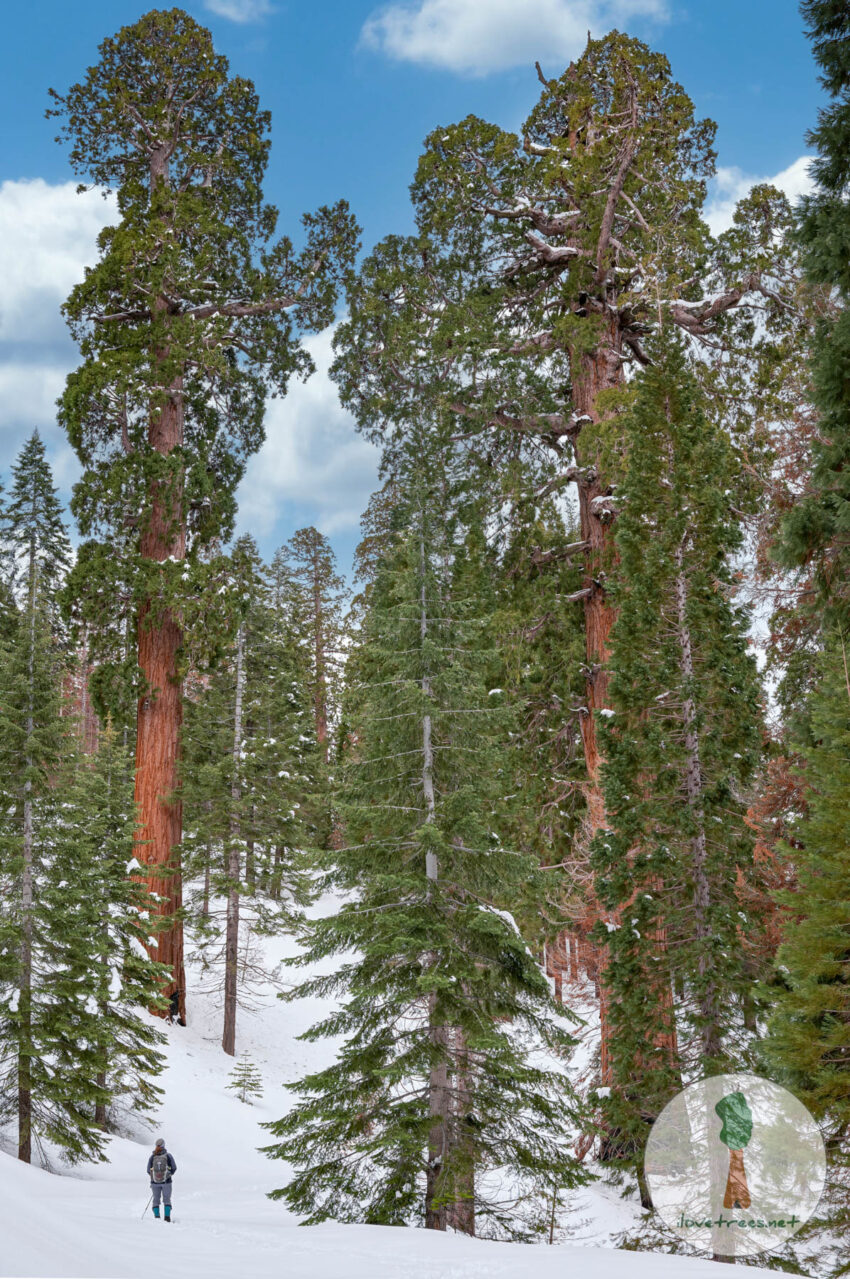How a Naturalist Found Herself Snowed in with the World’s Biggest Trees
by Sue Cag
The power went out. The roads crumbled. The people left. The snows came, then came again, and again. We were trapped. There was no way out now. We had made our decision to stay, despite the looks of fear in other people’s eyes. We accepted the risks. We wanted to be here. Even struggling and cold, we’d choose this path. Even if we couldn’t leave again for months, all the way until winter turned into summer perhaps, we’d stay. Why? Why would we do this? Everyone else evacuated. They escaped to their other homes, an option we didn’t have. We don’t even own one house, much less two. But more than that, this is where we belong. Among the trees. This is the only place I’ve ever felt at home. It’s why I’m still here, despite the immense pain from the fire that took my home and half my forest two years ago. I need the trees, nature, beauty. I wither away anywhere else. Trees are the very life-giving air to me. An existence without them is no existence at all. Plus, my partner and I wanted to be alone with them. And alone we were. We had an entire sequoia grove to ourselves.
I’ve been told that most people don’t like quiet, at least not for long. No place is truly quiet anymore anyway; silence has largely gone extinct. Even the most remote habitat is subject to personal, commercial, and military air traffic noise. When we look up at the sky, we see streaks of airplanes instead of clouds. At night, we see satellites instead of stars. I live on the steep slope of a mountain. To get here, one must drive up a narrow winding road, around blind curves with the abrupt edge of a canyon dropping away on one side. The nearest tiny town is an hour and a half away. The nearest decent grocery store is almost two hours away. In theory, the mountain should be a retreat from the stress and clamor of typical human life. But, when people leave the noisy and polluted valley or their home city and come up here, they bring the cacophony and commotion of their everyday lives along with them. All the way up a mountain. All the way into an ancient sequoia grove. No one seems to truly want what the forest has to offer. But I do. And this winter, I finally got it.
It started with the rain, relentless rain washing away every bit of snow we gained. In both early November and December, the rains came. It was 60 degrees on Christmas day. At the end of December my rain meter measured 7 inches over the course of five days. On January 9th, we got over 5 inches of rain in a single day. We received emergency notifications advising us to “shelter in place.” Water poured over the roads, eroding the earth beneath and pulling the asphalt apart. Mud slid downslope freely, loosened by recent logging and the absence of living roots to hold it in. The wind roared like a hurricane. Thunder rumbled and lightning flashed. A power pole went down. A few days later, the county issued an evacuation warning, stating that the only road on or off the mountain was closed due to landslides, and would likely get worse. Three days of snow followed, bringing us two feet of fresh powder, along with ice and wind. It was the first real snow of the season, snow that actually stuck around for a while instead of being washed away by rain. On February 22nd, a string of eight days of snow commenced, bringing a whopping six feet, along with another night of power outage. At some point our road stopped being plowed altogether. At the height of the mayhem, a car drove off the edge of the dilapidated route up the mountain. In a nearby community, a house burned down, followed by a lodge/restaurant two weeks later, both due to propane “explosions” when snow fell onto vulnerable lines. On March 10th we received a 12-inch deluge of rain. Springville, the nearest town at the base of the mountain and the town listed as our address even though we live high above it, flooded badly. The torrent of falling rain combined with melting snow caused the rivers to swell and overflow, submerging houses, land, and bridges, rushing into dams, spillways, and recreating Tulare Lake (once the largest freshwater lake west of the Mississippi before being sucked dry by agriculture). It continued to rain for five more days. On March 14th, our power went out, and didn’t come back on.
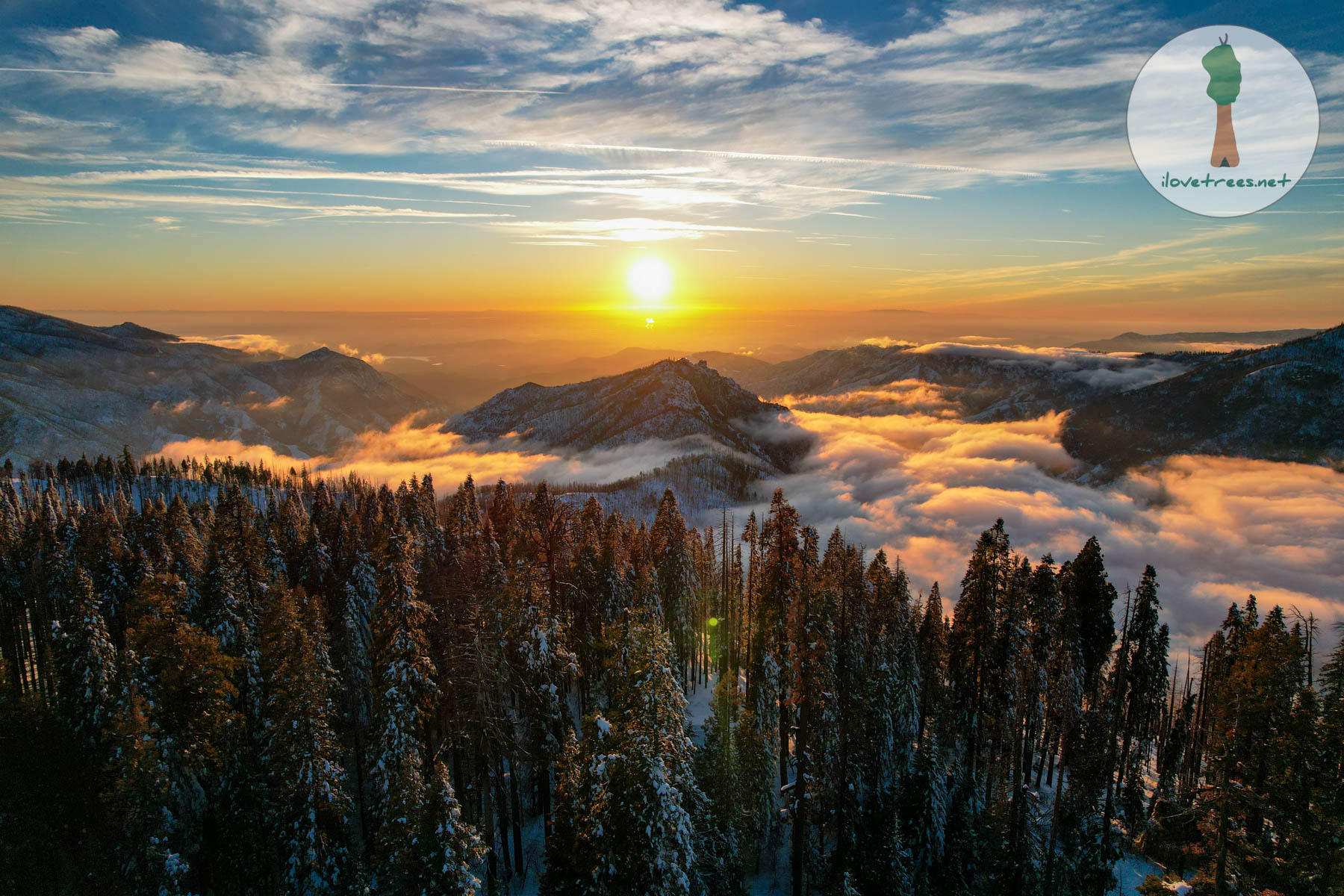
Three gigantic boulders released their burdens and slid down their steep slope, uprooting several trees and snapping power lines on the way to their new resting place, across the only road in or out of our community, blocking it completely. A neighbor came by the following morning to show us a photo of the wreckage, while we were wrestling with our generator, changing the oil and coaxing it to life. Two days later, a California Highway Patrol helicopter flew in and landed in front of the neighbor’s house down the street. A CalFire captain asked us to leave, saying the road is cut off and may become even worse during the next string of storms. He immediately took a poll of who was willing to be taxied out by helicopter, with one backpack each, plus pets. Of the nine of us left on the mountain at that point, three took him up on his offer.
The following day, a neighbor cleared a narrow route around the boulder-slide with his tractor. The county wasn’t going to do it, even though they’re responsible for the road into our community. CalTrans, manager of the highway that connects to our road, wouldn’t even glance at any of the damage. Thick chunks of asphalt fell off in numerous places. Water and mud pushed over and under the pavement, eroding it away. Trees and rocks tumbled into the road. One side of the highway washed out completely – a huge, gaping hole formed when the road was torn to pieces by a rushing creek. The next day, three more people evacuated and barely slipped out before the upcoming storms, graciously leaving us a stockpile of gas for our generator, propane to heat water or cook, and all the produce they had left in their warm refrigerators.
Unfortunately, as much as we love our cabin, it isn’t set up well for year-round winter living. It’s entirely too dependent on electricity, which frequently goes out. The house has a pellet stove which requires power to run (along with many store-bought bags of biomass). We wish we had a wood stove instead (with plenty of discarded wood available from the local forest). We were cold, so we ran a thick cable from the generator outside to the pellet stove, or to a power-sucking space heater. But how long could we do this before running out of gas? We had no hot water either, and the sink tap releases only frostbite-inducing, ice-cold mountain water. Heat and hot water were our only immediately concerns. Keeping fridge and freezer food from spoiling is easy, and we had plenty of candles, flashlights, and batteries for light and whatnot. We would eat cold food or cook on our camp stove. If we had our way, we would have set things up with a wood stove for heat. We could warm water on top of it as well. We also aspire to learn how to use cleaner energy for our other needs. We don’t have any of these options however, because this isn’t our house. We lost ours in the 2020 Castle Fire and we’re renting this one, because this forest is our home and we don’t know how to be anywhere else.
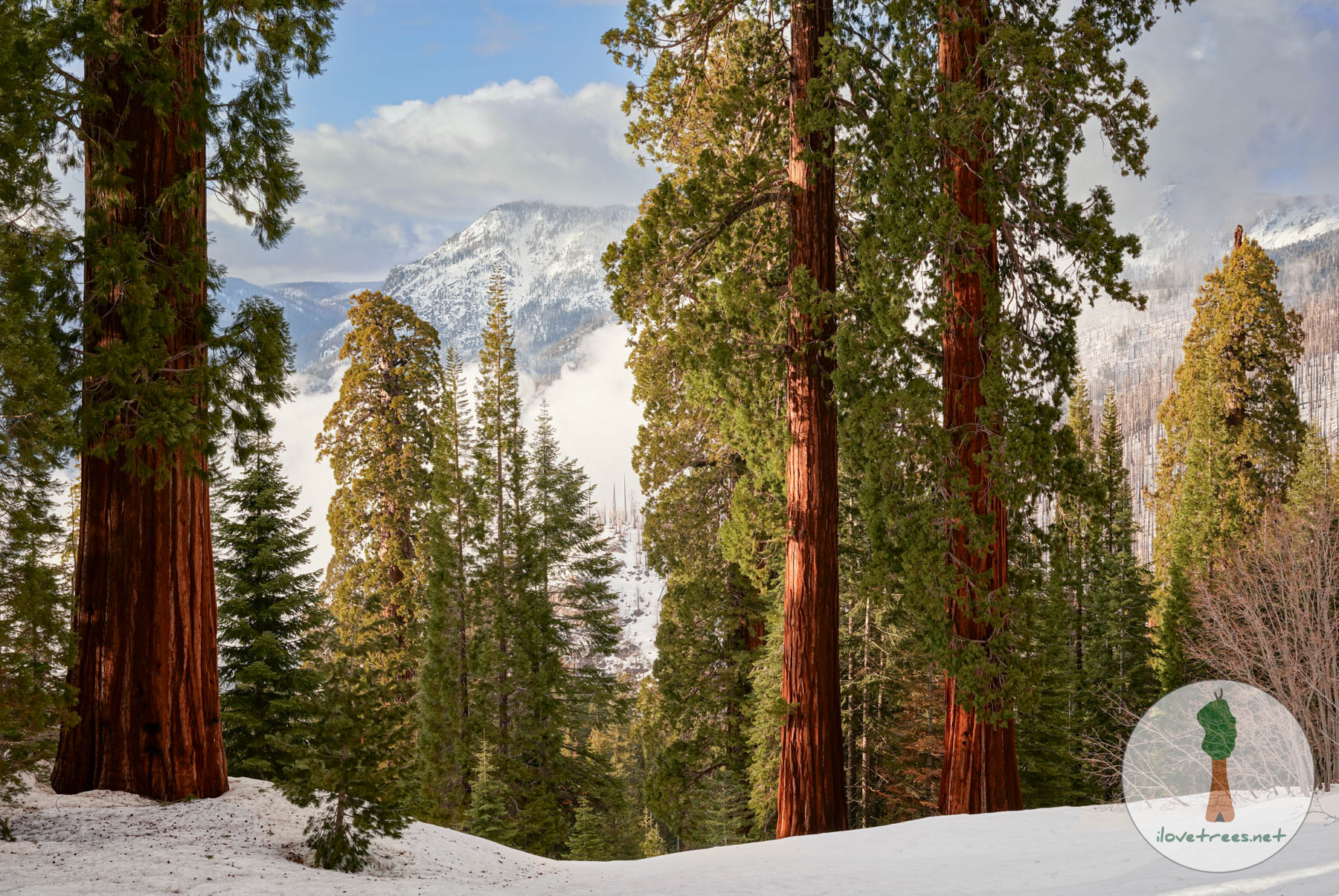
People thought we were crazy for staying. The power might be out for a month, or more? In addition to the landslides and crumbling asphalt plaguing the only road in, the upcoming snowstorms would guarantee no passage. The snow would need to naturally melt first, then the road would need to be fixed. It would likely be months, plural, before we could leave. No one would be able to get to us if we needed help. Did we have enough gas for the generator? Did we have enough supplies? And the most popular question of all – did we have enough food? Every single person asked if we had enough food. It made me laugh every time because it was the thing we were concerned with the least. We always stockpile food before winter comes. That’s the easy part. Our major concern was running out of gas, our only source of heat. But even if we did, the worst-case scenario would be that we’d be cold. We wouldn’t freeze. This isn’t the heart of Alaska. The lowest temperatures are in the teens and it doesn’t usually stay that low for very long – more typical winter temperatures are in the 30s. We’d be uncomfortable wearing heavy coats and our thickest clothing, but we’d survive. We’d even wrap our kitty in a leg warmer or stick her in our jacket sleeves.
A more valid concern was water. The water system could break or spring a leak, which it does from time to time. Not having running water is a real pain. We could get around it though, by using the heaps of snow outside and melting it on our pellet stove or camp stove. We also found our communication to the outside world was cut off along with the road. We didn’t have internet; it had been out for weeks with no indication it would ever be fixed. We don’t have a landline and there’s no cell signal to be had, except for the tiniest unreliable blip if you stand in a certain spot. If one of us was badly injured or had a medical issue, we would be unable to get help. Even if we could call out, it would be very difficult or downright impossible to get assistance.
All of these inconveniences beg the question, what was this worth to us? Why were we staying? Did the upside outweigh the risks?
This isn’t the first time we’ve done something like this. After the 2020 Castle Fire, we came back to our mountain like boomerangs, as soon as the authorities would permit us. We had no electricity since all the poles had burned down. It was uncharacteristically cold as well, with temperatures staying in the teens for days at a time. Miraculously, we had running water, though it wasn’t potable yet – so we had to bring jugs of drinking water. We had no hot water, so we boiled water for bathing. We also sometimes used a submersible water heating device that we ran off the generator. We lived this way for nearly a month. We were also alone. No one else was living up here at the time, not full time anyway, though there were many utility workers. An elderly couple also came back shortly after us, but they rarely left their house. No one from our community stopped by or checked on us, with the exception of one former neighbor who brought us a large container of much-appreciated gas. This time around, our neighbors impressed us. Before they left, they stopped by frequently and added 30 gallons of gas to our stockpile, along with two tanks of propane.
Our prior experience prompted our lack of hesitation this winter. We had done it before, we could do it again. This scenario was a bit different of course, with the road completely blocked (though we didn’t leave the mountain during our previous experience either). But the time before was also much harder because we were very vulnerable after just losing our only home and half of our beloved forest. We didn’t feel safe. In that fragile state, we had spent the first handful of nights watching red flames burn down a tree right behind our rented house, subsequently lighting the ground on fire. When we hiked around trying to find someone to help with the situation, the SQF Forest Service fire leader that finally arrived said that they don’t address fires that haven’t grown to two acres or more. The fire was half an acre from the house. It’s no wonder our previous home had burned down.
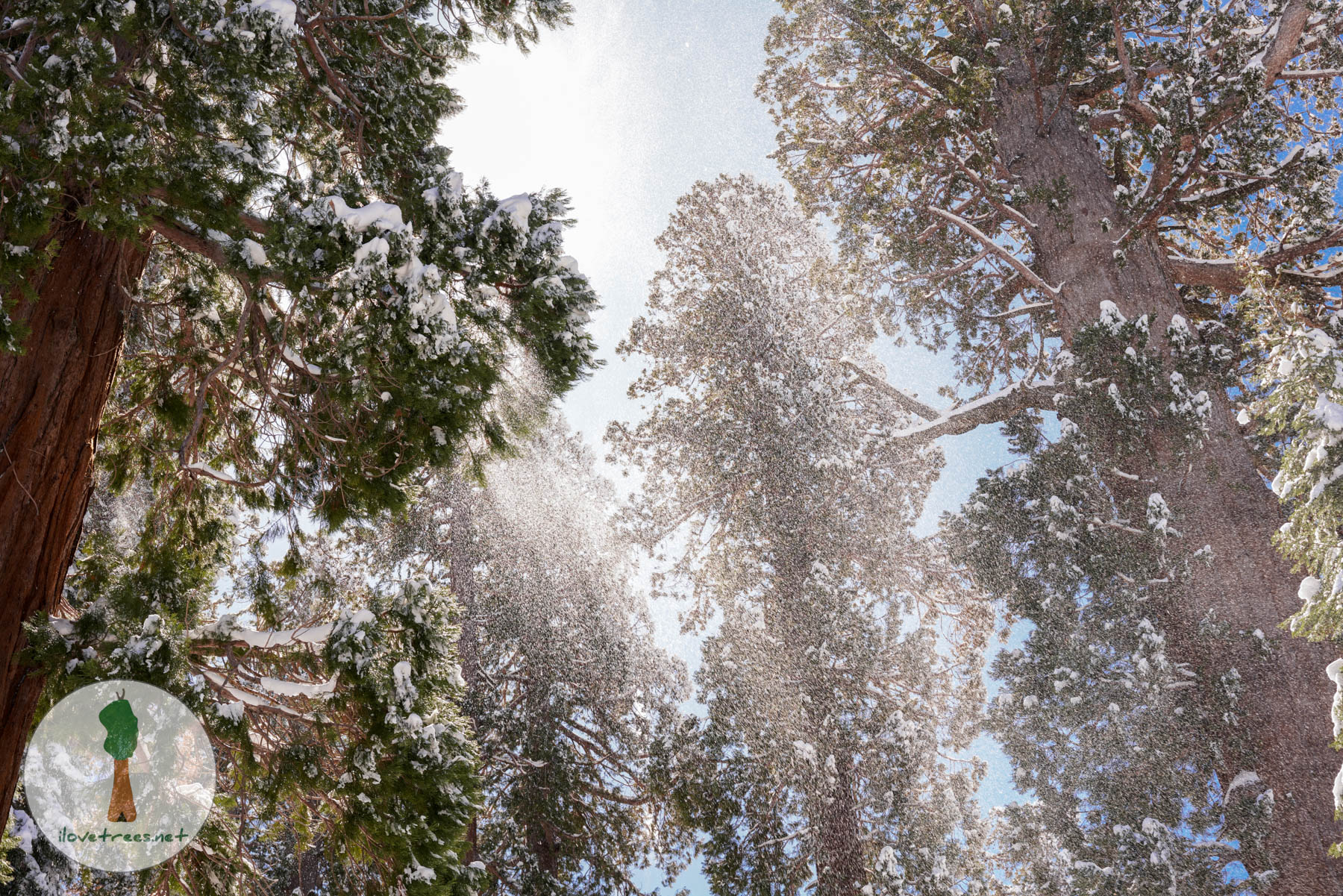
This time around, living alone on the mountain turned out to be wonderfully sublime. We were ready for it. We loved that no one else was here. We experienced absolute quiet. No cars or ATVs driving by. No plows. No chainsaws. No logging trucks. No utility workers. No tourists. No children screaming. No dogs barking. No burning. It was pure bliss. We watched a beautiful black bear, the first of the season, “wading” through deep snow, slipping and falling a little bit downhill. We followed his or her footsteps winding down the mountain, leading from one sequoia to the next. We observed bobcat prints, including many crossing our snowshoe tracks right after we passed by. At the cabin one morning, a bobcat sauntered nonchalantly across the driveway, without a care in the world, practically whistling as he or she strolled on by. We noticed a series of fox prints zigzagging every which way through the snow, uphill and down, tracking a squirrel or mouse. We watched as a raven peeled bark off a dead sequoia branch and whisked it away, presumably for his or her early nest. We found out that when it rains and ravens’ wings become wet, the magical flapping sound usually heard when they fly overhead turns into a muffled, almost silent beat. A western screech owl fluttered loudly and flew off from a tree in front of the cabin while I stood outside checking the snow level in the pitch-black night. A grouse whizzed past me and waddled through the snow uphill while I was standing on the icy abandoned road. A quail suddenly took off, scaring me into distraction, presumably to protect his nascent family. A sharp-shinned hawk gathered sticks and brought them to the construction site of his or her nest, 40 feet up in a thin fir tree. A nearby pair of band-tailed pigeons mated on a high bough, followed by sweet bowing and touching of faces. All of the juncos, robins, chickadees, nuthatches, brown creepers, and kinglets didn’t need to shout anymore, they could hear each other clearly in the absence of human din. Often, the knocks of pileated, downy, or white-headed woodpeckers were the only sounds heard, echoing throughout the quiet woods.
The Douglas squirrels were especially active this year, leaving their telltale tracks across our front steps each morning and crisscrossing the snow from tree to tree. They left huge heaps of fleshy cone “kernels” below many sequoias, in much larger piles than I had ever seen before. I thought of the triangular segments of dismantled cones as “kernels” since they vaguely resemble large corn kernels, except that they are green with a crimson exterior coating. They smell like watermelon. They look like miniature watermelon too, with pale seeds trapped in red fruit. I put a few pieces in my mouth to experience the flavor the chickarees were enjoying so much. It tasted like carrot-top greens. I watched one industrious squirrel at work through my binoculars, over two hundred feet high up in a giant canopy, sitting in the crook of a massive branch, munching away. The green cone fell to the ground, after having been eaten like corn on the cob. More often, the squirrels gnaw off the green cones at the stem and drop them onto the ground whole, to be consumed later. Dozens of both chewed and intact cones, along with hundreds of kernels and thousands of dislodged oat-sized seeds, were piled high on top of the snow. These caches not only appeared underneath the sequoias, but the firs and pines as well. Sure, squirrels have always been messy and wasteful eaters, and they always leave discarded cones below sequoias, but this was on a whole other level. Why were there so many uneaten kernels? Why were they left in such huge heaps? Was this a boom year for squirrels or were the sequoias somehow attracting this behavior? Were the female cones overly plentiful or irresistible? Sometimes unusual things like this happen in the sequoia forest. In the spring of 2021, the giants produced an inexplicable overabundance of male cones. It was a sight to behold, watching all of the domes turn from green to yellow-orange. No one knew why it was happening. At first, I thought it might be some sort of response to fire, especially to the severe sequoia-killing fire that happened the prior year. Maybe it was, but it occurred across all groves, including those that hadn’t burned. It begged the question, could the sequoias communicate across vast distances? Were they doing so again?
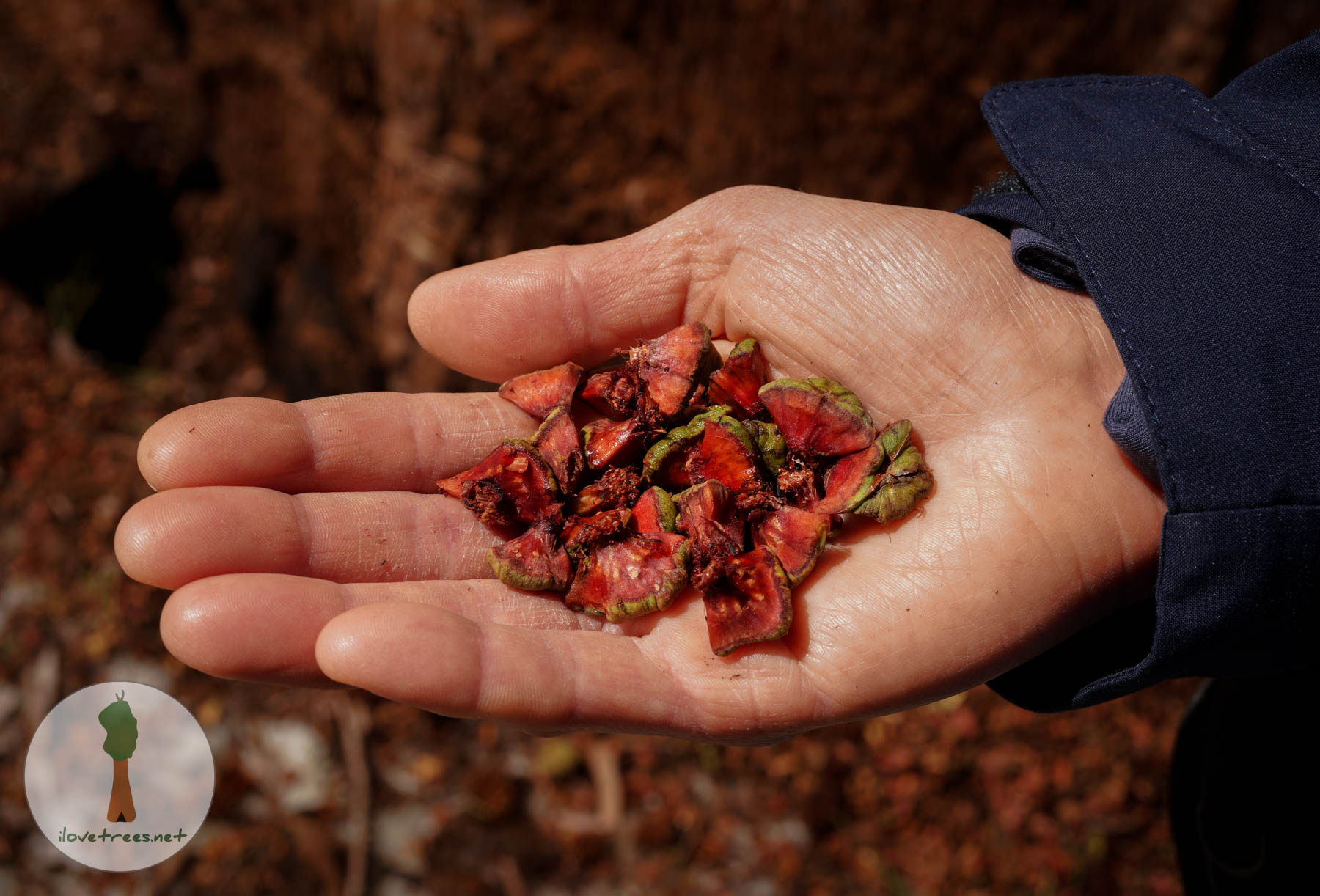
The vibrant orange color of the sequoia trunks changed to a purplish-brown after being soaked through by rain. The trees I knew so well looked so different, like how a drenched cat looks skinny and strange during a bath. I pressed my fingertip gently into the bark. Water trickled down from the spongy layers, as though I was wringing out a wet towel. When snow melted off the branches, dark lines streaked down the sequoia trunks, like charcoal or mold. The darker hue brought by rain or snow didn’t last long however, and soon the boles became their eye-catching orange once again.
Perhaps one of my favorite experiences during the winter happens while standing below as the snow slowly melts from the massive sequoia canopies. Not right after a storm of course, when dangerously huge chunks fall off and leave craters on the ground, but after that, when the snow melts gently. With one hand touching the soft trunk, I turn my face upward and let the falling droplets hit me, on my shoulders, on my arm, on my head, in my mouth, even in my eye. I stand below an ancient giant, baptized by sequoia rain, from an unreachable, unknowable crown far above. I enjoyed this experience after each series of storms. A few times, billowing mist froze on limbs and foliage, creating full domes of frost despite an absence of snow. When the moisture fell from the lofty giants, I caught tiny slivers of ice on my gloved hands. The ground surrounding each tree appeared covered in gems that shimmered in the sunlight. When I stepped back to look up at several of the tall crowns from a distance, the outpouring struck me as supernatural, like a group of forest titans crying cold tears.
There’s something truly magical about walking across virgin snow. It reminds me of an experience I had when was a child, one that may seem insignificant, but turned out to be pivotal, and impossible to forget. One early morning on a sparsely populated island off the coast of North Carolina, I walked out onto the beach alone. Not another soul was around. The wide open beach spread out before me, a huge swathe of perfectly smooth sand, pure and untainted. It was a time when large conch shells still rolled up on the shore regularly. I stood on the periphery for several moments before walking out onto the expanse. I was struck by the beauty of the fresh sand and the absence of other people. As I stepped forward, I realized that my footprints were the very first to walk across the beach, across sand that the water had rubbed clean the night before. My footprints were the first and only footprints. I was alone. I had the solitude to think, feel, walk, and explore, at my whim. While the island was far from a busy place, this was still unusual. I had stumbled into a tiny miracle. I had glimpsed the new, the impossible, the unknown. At the time, I wasn’t really sure why my young mind was so enamored by this or why it was so memorable. Perhaps it represented freedom, or perhaps deep down, I knew it was a sign of something bigger, a pull toward nature that would grip me forever and never let go. I feel the same sense of liberty, wonder, and love every time I step out onto a sheet of unspoiled snow. This winter, my footprints were the only footprints in the snow for miles. My footprints were the only ones in an entire sequoia grove. Over hundreds of acres, among three hundred massive and otherworldly ancient trees, it was just me.
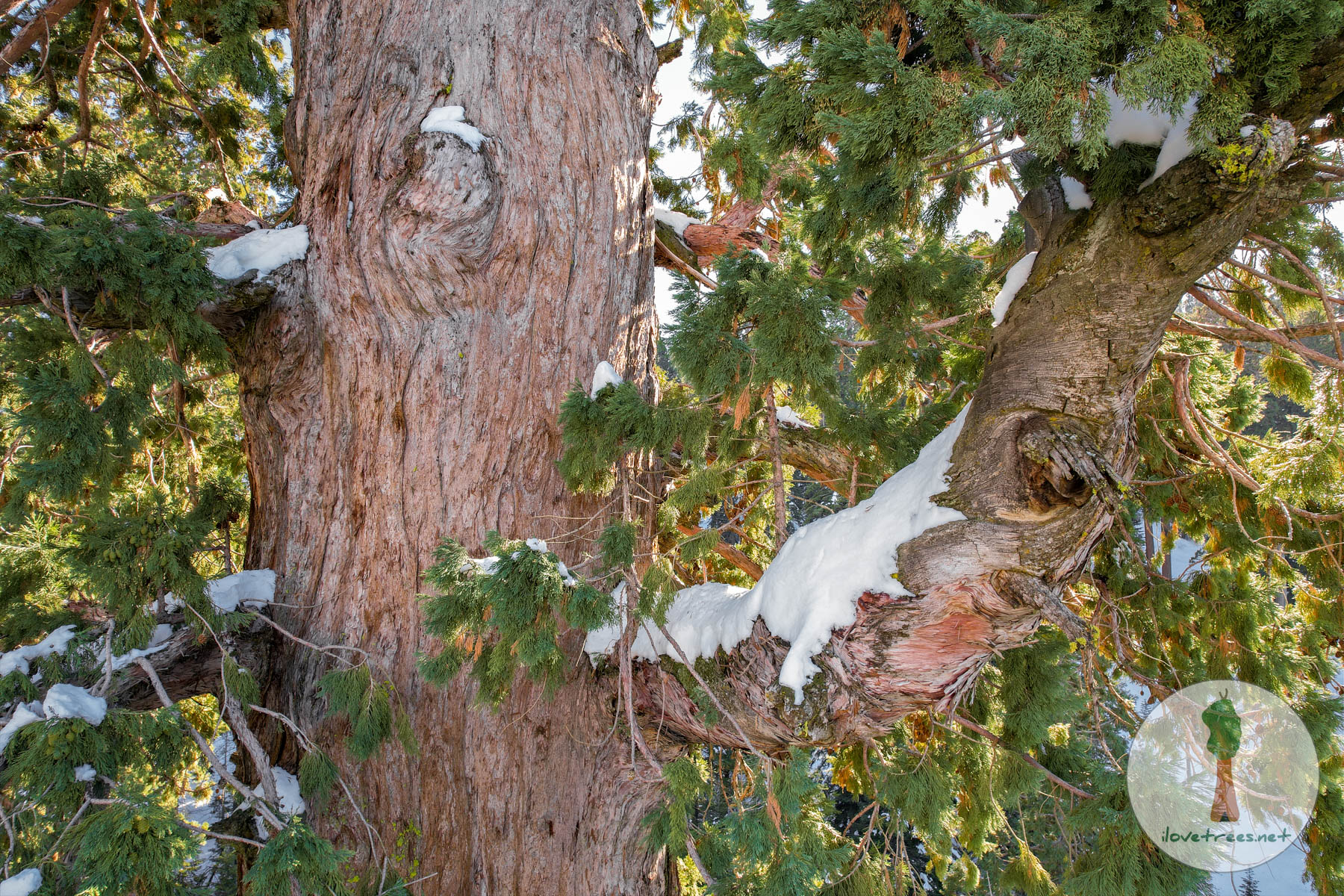
I felt honored every time I walked through a tunnel of small trees bent by the weight of fresh snow. Some bowed all the way down to the ground and lost their heads in it. Some disappeared completely and became anonymous lumps in a white landscape. I walked through the forest daily, except when the weather was too harsh or the frequent mists obscured my view entirely. While hiking steep slopes, chunks of snow often broke free from below my shoes and rolled downhill, accumulating swirling layers of powder to form aptly named “snow wheels.” Occasionally, a bunch of them got going at once, sped quickly downslope, crossed one another’s path, and created an amusing scene reminiscent of slapstick comedies.
A few times I found myself picking up small sequoia branches laying in the snow, discarded after being loosened by the wind. Cones, sticks, and limbs laid below every big tree, like clumps of hair on the floor after a haircut. One branchlet, full of lush foliage and clusters of green cones, felt heavier than I expected it to be. I gauged the weight of it in my hands, lifted it up and down, and tried to imagine how much heft the sequoia crown must be holding aloft. The enormity of it seemed impossible. I placed the branch back down below the tree and picked up a piece of old gray wood. How old was it? 500 years? 1,000 years? 2,000? 3,000? I held in my hands a fragment of the past, a relic that made “old” classic paintings in a museum seem recent. I had the unbelievable privilege of standing below an ancient being that may have been born before Jesus, and continues to live on in the same spot. It felt like reaching into the past, present, and future all at the same time.
Tall “snow skirts” surrounded the base of each and every sequoia. I call them “snow skirts” because of how the snow clings to the sides of the trunks and drapes down in a skirt-like fashion. The top band forms a smooth line or zigzags between furrows. When the temperatures rise and the trunk warms, a gap separates snow from tree, revealing multiple layers of wavy frost. Sometimes the snow “rolls” away from the bole like a blanket. A fringe of duff often stays behind, marking the snow line, along with thousands of minuscule white springtails. I climbed up innumerable sequoia snow skirts to reach trunk parts I had never seen or touched before. It felt like being on a ladder, or on stilts. I was taller, able to examine burls and characteristics previously beyond my small stature. I was lifted closer to the canopy. My brain struggled to accept the differences I perceived, insisting that the ground is always stable and unchanging. Limbs in the crown high above seemed to have moved closer, but it was me who had moved closer to them. This cognitive dissonance was even more easily recognized when standing on the top of a street sign barely poking out of the snow. I knew how high the sign was before and how much snow I must be standing on to be above it, despite the ground remaining flat and seemingly unaltered. I also knew what each familiar sequoia looked like prior to the snowfall. I knew that a certain burl was 6 feet above the ground for instance, and now it was located below my feet as I was standing on top of the snow.
During my numerous tranquil snowshoe walks through the grove, I had the Stagg Tree, the fifth largest tree in the world, all to myself as many times as I wished. On one occasion, the aroma of watermelon enveloped me completely as soon as I reached the immense trunk, originating from innumerable freshly gnawed and discarded cones littering the ground inside the old, buttressed fire cavern. I touched the top of a burl that was unreachable before. I felt gleefully elevated while standing on top of the snowbank below the mammoth tree. The bottom of the deep fire scar was far below me now, the top closer to my grasp. Snow usually makes the sequoia trunks appear slimmer, but the Stagg Tree still looked huge. On another occasion, from a broad viewpoint above, I watched as the giant’s multi-speared crown gradually hid behind a thick shroud of mist, turning into an opaque silhouette before vanishing altogether. It was nature’s grand illusion, making the fifth largest tree in the world disappear, putting every phony stage show to shame.
I also had the eighteenth largest tree in the world to myself, an enormous giant that my partner and I discovered, or first documented. It seems impossible that such an immense tree went largely unnoticed until now, but it happens from time to time. We admired the giant for years before I told a friend about it, and since he’s a Wendell Flint-inspired big tree seeker, he came out to measure it. No one else knows about this tree, yet. It holds 35,693 cubic feet aloft, even after losing the middle section of its top in the Castle Fire. Affectionately referred to as the “Alder Creek Giant” or “AC” for short, the monarch is my very favorite sequoia in my own (temporarily) private grove, standing on a steep hill where no one else wanders except for wildlife and us. My partner and I snowshoed up to the giant countless times throughout the winter. When we head out for our typical day-long explorations of the grove, we seem to be habitually drawn to it. I’ve taken top to bottom photographs of it in every season. I can spot the tree’s distinct leaders from many points across the slope. Every single time I walk up to its base I’m utterly astonished at its sheer bulk, its imposing presence, and its incredible resilience after the fire.
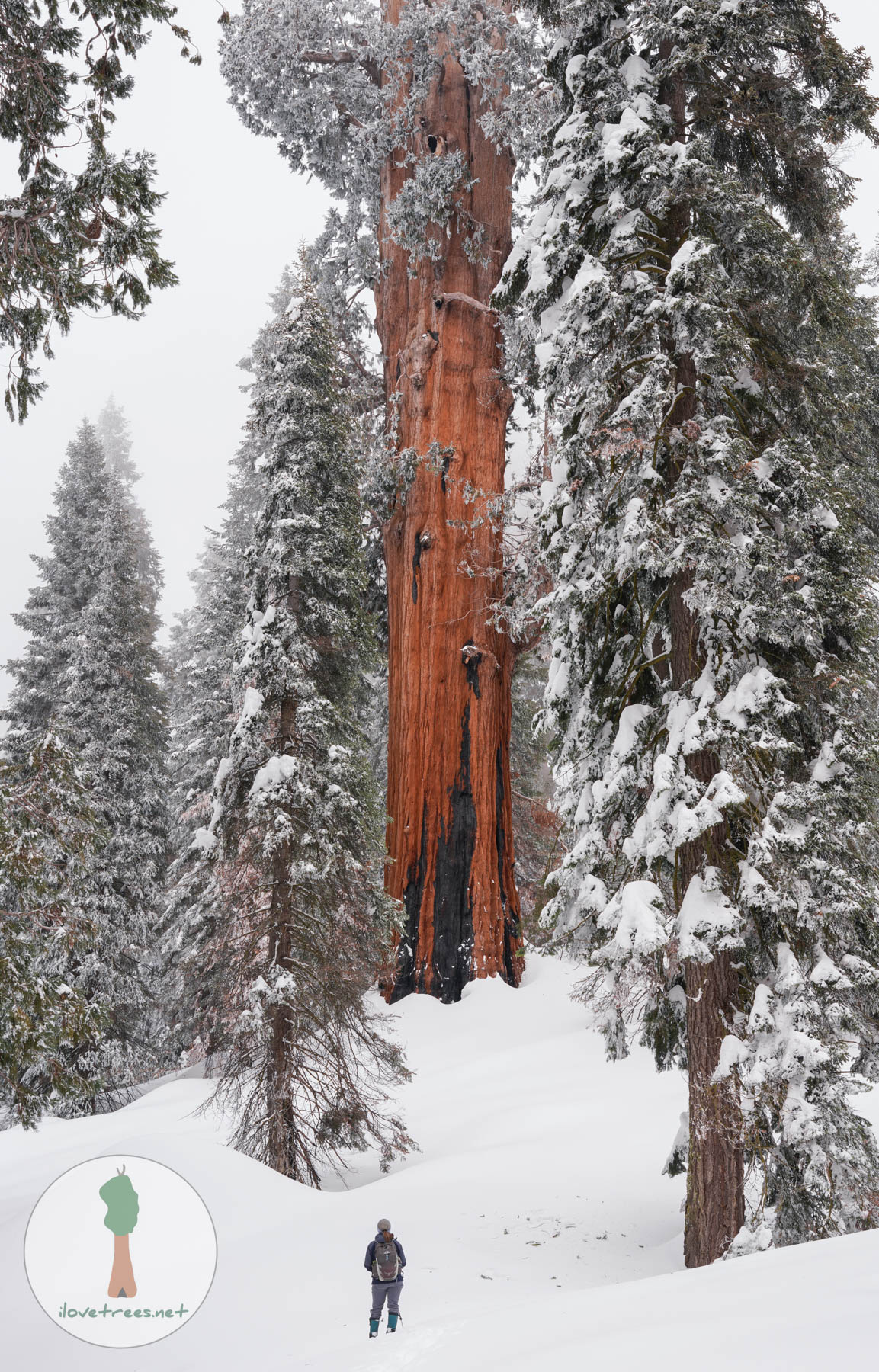
During one stranded-on-the-mountain snowshoe trek, my partner and I were greeted by an intensely sweet scent in the air, coming from a giant we pass by frequently. Most people don’t realize that sequoias smell really good. I guess we seldom think about the scents of trees, as we do of flowers. I experienced the unique fragrance for the first time several years ago while examining a pair of unnamed sequoias in the Giant Forest. Later, I asked a park ranger about it and he had no clue what I was talking about. Since then, I’ve put my nose to hundreds of sequoia trunks. Most are syrupy sweet with earthly undertones, and the spaces between furrowed bark hold the strongest scent. Moisture and sunshine often impact the aroma. Pieces of freshly broken heartwood smell like sugary fruit. The cones of some sequoias smell like hyacinth, but I believe this is rare. This time the sequoia scent wasn’t coming from the trunk or other tree parts, but rather from the air surrounding the tree. This had never happened before, at least never so strongly. Was the scent being released by the foliage? I’m not sure that’s it, since sequoia foliage smells like “greens” and isn’t sweet at all. Could it be a result of plentiful moisture? Or could the tree be purposely emitting a pheromone for some reason? Could we really be smelling it so powerfully?
Perhaps the most striking sight I stumbled across while walking alone in the winter woods, and certainly the one that excites everyone the most, was the spectacle of an avalanche that had just occurred. It was a big one, about three quarters of a mile in length, descending 1,700 feet from craggy rocks high above. It uprooted the trees in its path and threw many of them into the creek below. The vast chute now resembles a ski slope, except for the raised sides and a large hump of snow near the bottom. A few buried root-balls poke out above the expanse of white. I climbed to the top (via a safe route) to observe the sharp arête where the run originated. The powder was deeper and more impressive than I had ever seen it. Drifts protruded out over the edge of granite, levitating above empty air. Thick snow curved along the contour of the winding ridge, reminding me of fantastical pictures of the Alps. On the side of my mountain, at about 8,000 feet, I was completely surrounded by a 360-degree panorama of snow-capped peaks. I spent hours taking it all in. I took pictures and looked around using my binoculars. The sequoia domes were below me now, about 1,000 feet downslope. My mountain’s apex was 1,000 feet above me. The sun, which had previously bounced off the snow and burned my face, slipped behind rapidly expanding clouds, causing me to change from a long-sleeve shirt to a heavy jacket. A few weeks later, I noticed evidence of additional snow and debris impact at slightly lower elevations, spanning about a quarter mile in width. It appears that water, land, and snow descended down many secondary paths of least resistance, such as former skid-rows, taking out many small trees along the way. The surge also left countless neatly-stacked bundles of sticks pressed against the upslope sides of every single tree. I shuddered at the sight of them because they looked like tinder placed below each trunk, or purposely amassed burn piles, ready to be lit.
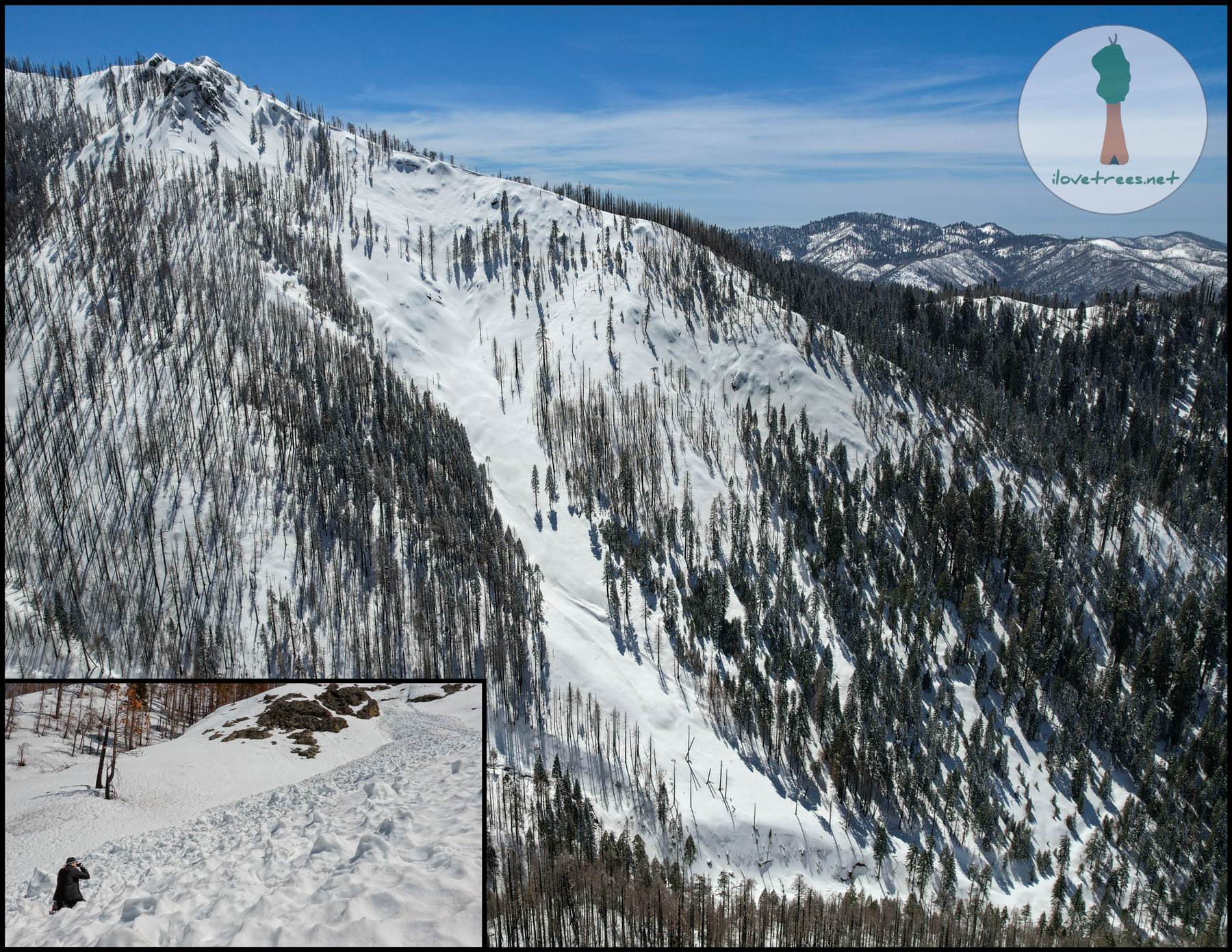
The electricity at our cabin was finally restored due to the diligent efforts of my partner. Apparently, you really need to harp on the fact that there are power lines dangling in the middle of the street. We had one glorious day of warm showers, hot food, clean laundry, and a non-freezing house. Then the electricity went out again. This time, the outage impacted a much larger area. The time frame given for restoration was weeks later. Luckily, we didn’t have to wait that long. Since then though, we cringe every time the wind blows and the lights flicker. We keep up with laundry and make sure everything is charged at all times, knowing that electricity on a mountain is a privilege, and unreliable.
When I received news from the outside world, I heard headlines describing the Sierra snowpack as the highest it has ever been. Was this accurate? Was this measured at high altitudes not subject to fast melt due to hotter temperatures? Was this true for my neck of the woods? I measured over 20 feet of total snowfall this winter season, at 6,600 feet elevation, but how does this translate to “snowpack?” Most of the snow we received was washed away by rain. How much was left under the trees, and for how long? The simple snow total looks good but doesn’t say anything about how it needs to stick around and melt slowly, in order to sustain the trees through the hot, dry summer. Until the storms of late February of this year, when snow finally remained on the ground for a while, I considered it utterly misleading. I still do, or I’d at least like to discount the snowfall that washed away quickly. Plus, lighter, drier snow sinks fast and should probably count as less moisture than denser, wetter snow. Still, the total is striking compared to prior years. We received 14 feet during the winter of 2018-2019; 12 feet for 2019-2020; 7 feet 8 inches for 2020-2021; and 8 feet 6 inches for 2021-2022. The normal, pre-drought yearly snow, as documented by old timers, totaled 16-18 feet. One year in the 1990s, the grove received an unusually large amount of 30 feet. In February of 2020, when there should have been plenty of snow on the ground, I hiked through ten shockingly snow-free groves – despite a nice-sounding 12 feet of total snow that winter. High temperatures had caused the snow to melt rapidly and fueled the fire that took my house and thousands of sequoias. There’s more to the story than specious sound bites. Temperatures in early April of this year swung wildly from 20 degrees to 70 degrees, resulting in rapid snowmelt.
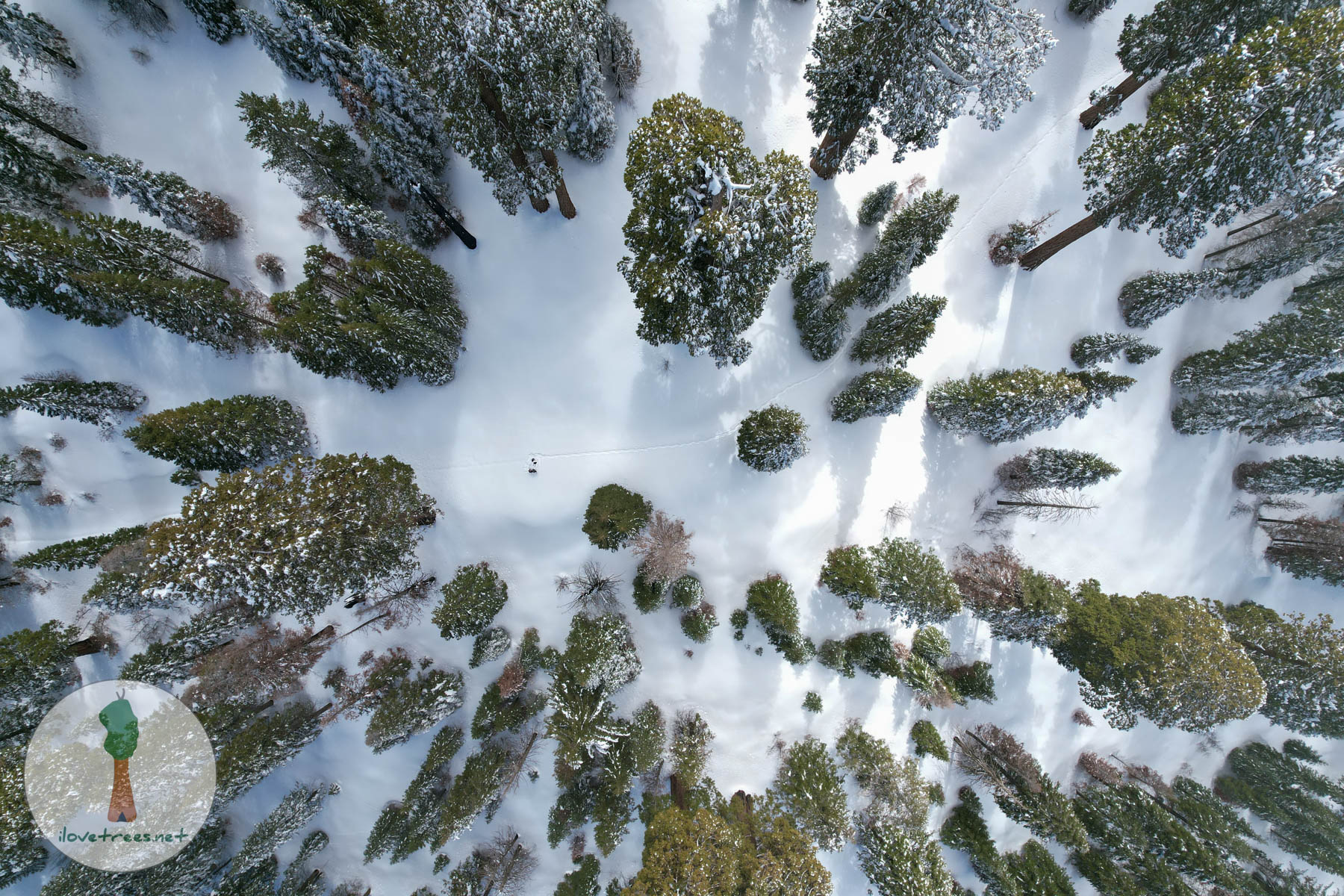
Wintertime usually offers a break for the trees, a break from people, logging, fire. The forest exists for its own sake, subject to nature’s whims, and free from ours. It’s usually a recuperative break for me too. It’s the only time I feel safe from fire, the kind that took away my home. I also picked a place to live far from any city or town on purpose. This year however, in addition to unattended burn piles that smoked and plumed for several months, tree cutters were back in full force in February. Log trucks and work trucks poured into the community, despite a dangerously crumbling and supposedly “closed” road. Chainsaws roared. Vehicles blocked the road. All this with feet of snow on the ground and more in the forecast. After one storm, utility workers drove by my cabin in a miniature snowcat for no apparent reason, but couldn’t be bothered to do so when the power actually went out, at least not without excessive nagging. This sort of relentless human activity spills into the farthest reaches of our planet, almost without exception. It should come as no surprise to find it in a rare sequoia grove. The absence of it on the other hand, if only for a few months, was unexpected, and extraordinary.
The experience of being blissfully trapped in a sequoia grove has ultimately made me feel like a caged animal who has been released into the wild after many years, tentatively wandering around my new surroundings. I finally gulp in the quietude, ultimately relaxing and leaning into it. I breathe freely for the first time. I realize that I need this. I need more of this. I need it permanently. Can I go back to before? Am I truly wild or am I permanently domesticated? Is this an escape or is it home? For the moment, winter has reluctantly turned into spring as I continue to be stuck in my sequoia grove, slightly feral perhaps, residing atop my mountain alone. But not really alone. Throughout this experience, I was never alone, at least I never saw it that way. Life surrounds me. Numerous birds and wildlife live close by. Trees and plants grow and thrive all around me. While we’ve been taught that trees are mere things, they are, in reality, living beings. The sequoias in particular are ancient elders who’ve seen it all. They are also my friends. I have paid so much attention to them that they’ve become more familiar to me than many people. I’m spending quality time with them as much as possible because I can’t say how long this experience will last. I don’t know whether the road will hold, or not. I don’t know whether I’ll be inundated with people and their noise soon, or not. I’ve seen the impossible become possible. I’ll just have to wait and see what happens next.
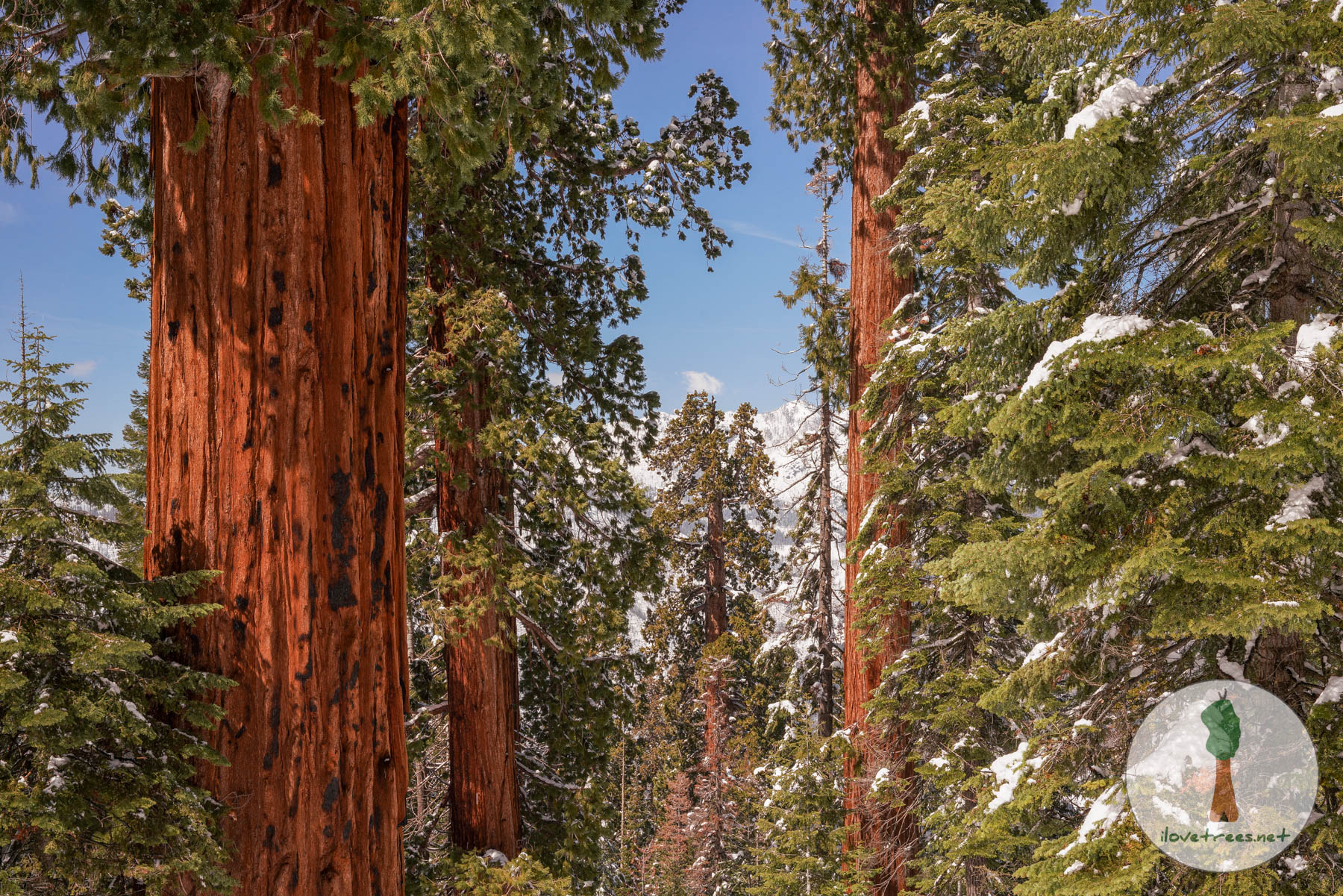
Epilogue
As winter turned into spring, snow melt began to reawaken streams, tributaries, and drainages that had previously been dry after years of drought. The creek closest to my cabin burgeoned into a wide waterway, fed by several forks heading downslope. While snowshoeing I heard the rush of water in a place I had never heard it before and looked around to find a little stream flowing alongside a sequoia, complete with tiny cascading falls. The snowpack was shrinking fast. Snow skirts were diminished, first on the sequoias’ warmer sides, especially where other trees had been cut down, and more slowly on the cooler, north-facing or shaded sides. I looked up with amazement at points on the sequoia trunks I could no longer reach because I wasn’t elevated by the snow anymore. The cone kernels that Douglas squirrels had piled high shriveled up as they dried out and vanished into the mix of thick duff formerly hiding beneath the snow. Scores of logs and uprooted trees were revealed at the avalanche site, many more than I thought there would be. Wildlife began to emerge in more significant numbers. On four separate occasions, I witnessed a bear, bobcat, coyote, and a grouse leisurely sauntering down the road, in a forest they reclaimed as theirs, which it was. The world had become wilder by human absence.
I continued to snowshoe nearly every day, mostly keeping to the upper reaches of the grove where the snow remained deepest. I slid around on the newly slick melt, as though skiing or slipping on banana peels, despite the craggy teeth of my mountaineering snowshoes. The thaw made my tracks disappear shortly after I passed by. I liked that. There would be no lasting sign of my presence in the woods.
I noticed the first buds of spring opening, starting with chinquapin, gooseberry, hazelnut, manzanita, and phacelia, at about the same time I began sensing the end of my winter seclusion. The snow blocking the road had melted, and while most people were smart enough not to risk life and limb on a terribly unsafe and not really passable road (including an “off-roading” portion around the big boulder slide), a few came and went. People seemed eager to treat the dangerous conditions as normal, even though any of the numerous road cave-ins could drop their tenuous pavement at any time. The loggers were also raring to cut and burn, even though they won’t be able to get large trucks in for some time, as road repair estimates range from the end of summer to the following year.
I could write a book about all that has happened and all that continues to unfold. There is so much I omitted. I didn’t write about the wondrous ocean of clouds that often forms below the grove after a storm, blotting out the world beneath. I didn’t get around to mentioning the chute made by a bobcat sliding downslope on his or her butt. I left out how I watched moisture leaping off treetops like puffs of smoke before morphing into actual clouds. Or how frost defied gravity by drifting upward instead of down as it departed sequoia crowns. I neglected to recount how burned forests resemble deciduous trees when covered by snow, and look quite pretty, or how these scorched areas, when left intact, attract the most wildlife. I only wish the grove had seen this winter’s abundance of moisture before the 2020 Castle Fire. I wonder if it would have been enough to change the outcome of what happened to my home. I had been so full of joy before the fire happened. I relished every moment I spent among my beloved trees. I never thought I’d ever feel that way again. But this winter changed that. This winter revived the joy that I thought I had lost forever. The quiet was truly a gift, and the glimpse into what should be and what could be was nothing short of a revelation.
Download this story for offline reading: The Winter I Got Stuck in a Sequoia Grove.pdf
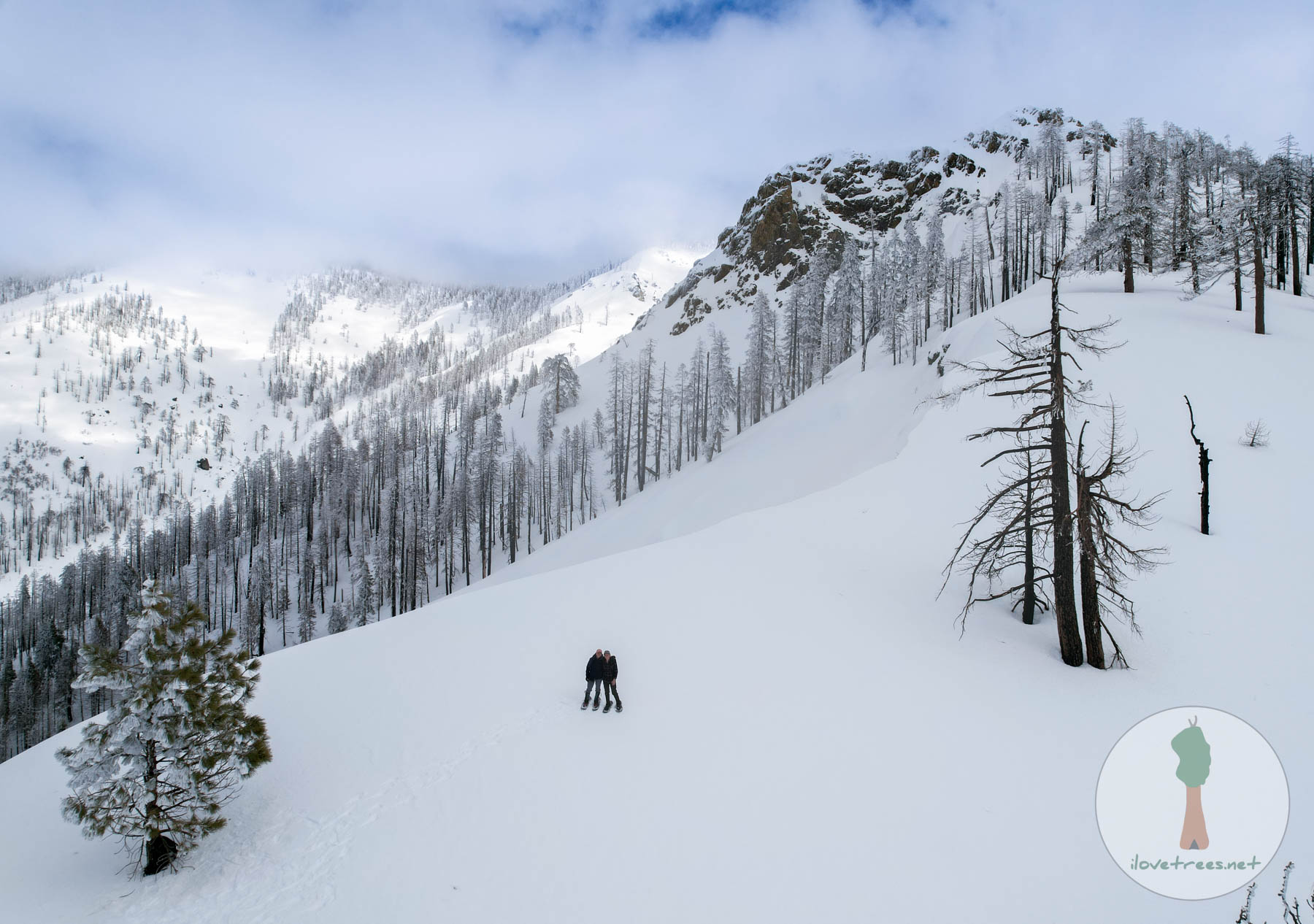
Gallery
[random order ~ click on images to see captions]
![]() About the Author: Sue Cag is a musician, artist, writer, photographer, and nature preservationist.
About the Author: Sue Cag is a musician, artist, writer, photographer, and nature preservationist.
All photos and video by Sue Cag. All Rights Reserved. Photos and video may not be used without permission.

